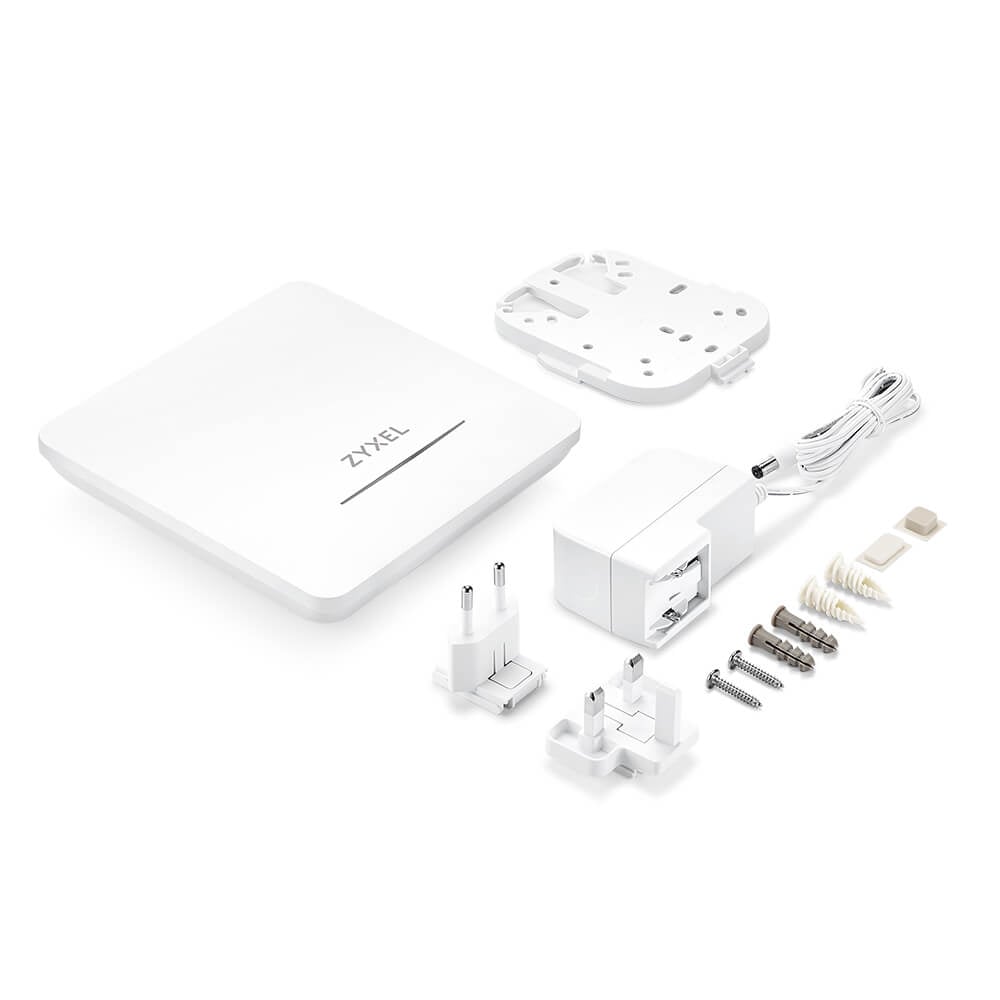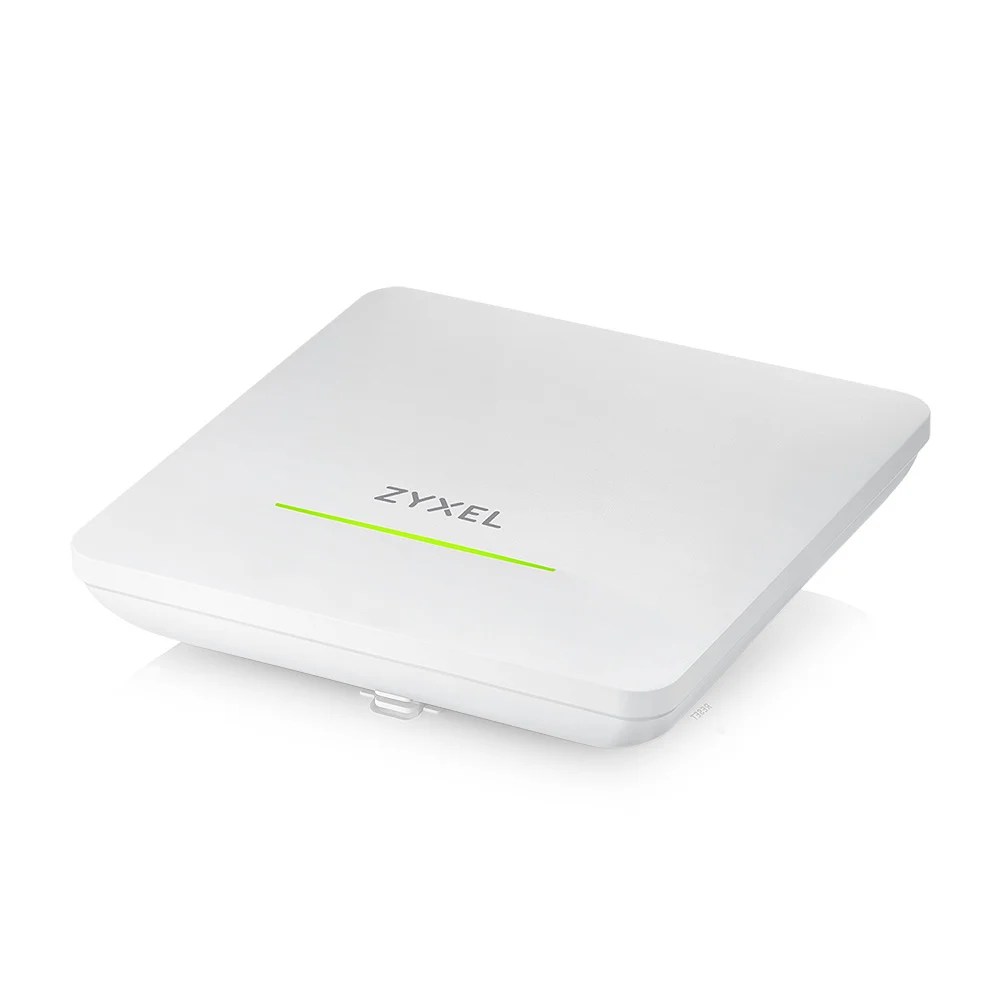Zyxel today introduces four new business Wi-Fi access points to its existing Wi-Fi 7 portfolio, including the NWA90BE PRO BE6500 4-Stream WiFi 7 Dual-Radio NebulaFlex Access Point (model NWA90BE PRO), the NWA50BE PRO BE6500 4-Stream WiFi 7 Dual-Radio NebulaFlex Access Point (NWA50BE PRO), and their non-PRO variants.
These new APs are pretty different from Zyxel’s previous Tri-band models. The first thing to note is that all of them are dual-band, or “dual-radio,” as Zyxel puts it. The second is that two of them, the PRO versions, actually have the 6GHz option. And finally, all of these are practically the same. How come?
Let’s find out more!

Zyxel’s four new dual-band Wi-Fi 7 access points: Largely the same
As mentioned, these new access points include two main models, the NWA90BE and NWA50BE, each with its PRO version.
Both PRO versions have something the non-PROs don’t: They come with the 6GHz option. However, they are still dual-band hardware because users can pick either the 6GHz band or the 5GHz band at a time, in addition to the 2.4GHz band. On the other hand, the non-PRO versions are limited to 2.4GHz and 5GHz. They are more straightforward dual-band hardware.
The 5GHz/6GHz selectable notion is not new, and in real-world usage, the 6GHz band is likely not often used, as in most cases, the 5GHz band is more frequently needed. While having the option is always a plus, practically speaking, the PRO versions don’t offer a significant advantage.
The table below shows the hardware specs of the new access points. Apart from the 6GHz notion of the PRO models, they are essentially the same hardware and all share an identical design and physical shape. In fact, they are so similar that you will not be able to tell any of them apart, and personally, it was initially hard for me to figure out why there were four models and not two.
Zyxel dual-band Wi-Fi 7 access points: Hardware specifications
| NWA90BE PRO | NWA50BE PRO | NWA90BE | NWA50BE | |
|---|---|---|---|---|
| Wi-Fi Standards | Dual-band BE6500 | Dual-band BE5100 | ||
| Broadcasting Power | US (2.4GHz/5GHz/6GHz): 26/25/22dBm EU (2.4GHz/5GHz/6GHz): 20/25/22dBm | US (2.4GHz/5GHz): 26/25dBm EU (2.4GHz/5GHz): 20/25dBm | ||
| 6 GHz Speeds (channel width) | 2×2 BE: Up to 5764 Mbps (20/40/80/160/320MHz) Selectable with the 5GHz band | None | ||
| 5 GHz Speeds (channel width) | 2×2 BE: Up to 4324 Mbps (20/40/80/160/240MHz) Selectable with the 6GHz band | 2×2 BE: Up to 4324 Mbps (20/40/80/160/240MHz) | ||
| 2.4 GH Speeds (channel with) | 2×2 BE: Up to 688 Mbps (20/40MHz) | |||
| Number of SSIDs | 8 (single or multiple bands) | |||
| Multi-Link Operation (MLO) | Yes | Yes | ||
| Automated Frequency Coordination (AFC) | No | No | ||
| Operating Mode | Standalone, NebulaFlex cloud controller | |||
| Roaming Standard | Pre-authentication, PMK caching, and 802.11r/k/v | |||
| Backward Compatibility | 802.11/axe/ax/ac/n/g/a/b | |||
| Power over Ethernet (PoE) | 802.11at (PoE+) | |||
| Max Power Draw | 16W | |||
| Injector Included | No | |||
| DC input | DC 12 V | |||
| Adapter Included | Yes | |||
| Multi-Gig port | 1 x 2.5GBASE-T PoE+ (uplink) 1 x 2.5GBASE-T | |||
| Gigabit Port | none | |||
| Wireless Security Methods | WEP/WPA/WPA2/WPA3 | |||
| Authentication | Wi-Fi Password, Captive Portal, WPA3-Enterprise, 802.1x, RADIUS | Wi-Fi Password | Captive Portal, WPA3-Enterprise, 802.1x, RADIUS | Wi-Fi Password |
| Access Management | L2-isolation/MAC filtering/Rogue AP detection | |||
| Mobile App | Zyxel Nebula | |||
| Dimensions (W x D x H) | 5.91 x 5.91 x 1.38 in (150 x 150 x 35 mm) | |||
| Weight | .91 lbs (412 g) | |||
| Processing Power | Quad-core Qualcomm chipsets | |||
| Operating Environment | Temperature 0°C to 50°C / 32°F to 122°F Humidity 10% to 95% (non-condensing) | |||
| Release Date | September 29, 2025 | |||
| US Launch Price (Check street prices!) | $99.99 | $89.99 | $79.99 | |
Practically the same hardware with slight differences in firmware for different user demographics
As shown in the table, there are essentially two series, including NWA90BE and NWA50BE, each with a PRO version.
As mentioned, these APs have identical physical shapes, and there’s little difference between them in terms of hardware. In fact, the PRO and non-PRO versions are virtually the same in specifications. In terms of functionality, all of them can work either as standalone standard access points or part of Zyxel’s NebulaFlex system, and share virtually the same SSID configuration and client support.
On their specific differences, Zyxel provides these extra details:
“The NWA90BE PRO and NWA90BE are designed for businesses such as cafes, hotels, clinics, and shops that offer guest WiFi access. They have robust security features, including RADIUS Authentication and a Captive Portal, enabling businesses to manage guest connectivity and secure the login experience.
The NWA50BE PRO and NWA50BE are ideal for small businesses and SOHO users seeking a cost-effective, high-performance upgrade. Ideal for home offices, compact workspaces, and residential use.”
As it turns out, the only meaningful difference is in the firmware. These APs are targeted at different user demographics, with the NWA90BE series offering more authentication methods to meet enterprise-class requirements, whereas the NWA50BE series is slightly less sophisticated and suitable for a more standard Wi-Fi setup.
That said, the NWA90BE series encompasses the NWA50BE series, and home and small business users can use all four APs interchangeably, with a likely similar real-world experience in terms of getting connected. Most importantly, it’s perfectly fine to get confused between them because they are all affordable.


Pricing and availability
Zyxel states that the NWA90BE and NWA50BE, as well as their PRO version, are now available at the suggested retail prices of $89.99 and $79.99, respectively, each with an additional $10 for the PRO version. As usual, their street prices will vary.
At these friendly price points, these dual-band access points are safe purchases for those who need modest Wi-Fi 7 bandwdith. So, check them out today! If you’re still undecided about which to choose, it’s generally safe to opt for the least expensive version.



Would these work fine with a Unifi router (UX7)? I like that I could get two of these for the price of a U6/7 AP
They will work fine, Rob, but you’ll have to manage them separately. You’re better off with the U7-lite, though. Similar specs and cost.
Thanks, I’m not sure how I missed that one!
👍